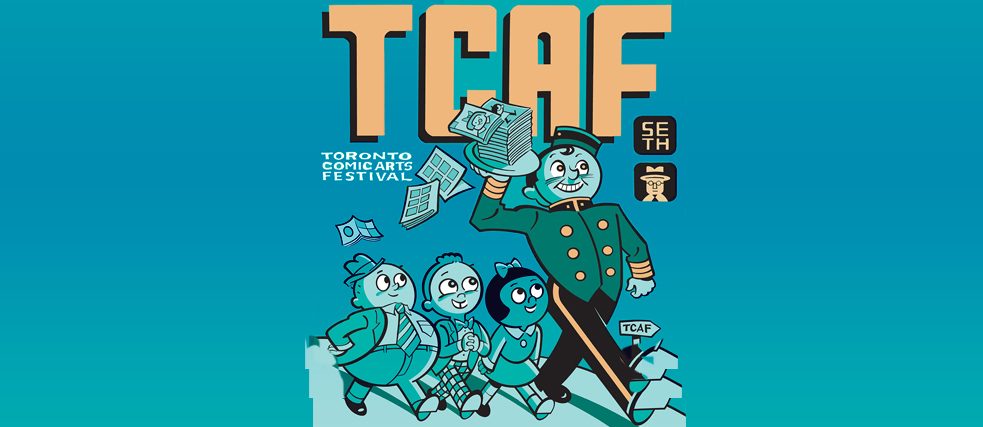Toronto Comic Arts Festival 2019
A piece of "Heimat" in Toronto

Now in its 16th year, the Toronto Comic Arts Festival continues to cement its place as one of the world’s premier events in comics and graphic novels.
By Laura Kenins
With its usual packed schedule of exhibitors, signing and panels, this year’s festival featured a series of popular events with reknowned Japanese artist Junji Ito, and some highly anticipated Canadian book debuts like Seth’s Clyde Fans, Emily Carroll’s When I Arrived at the Castle, Vivek Shraya and Ness Lee’s Death Threat, and Mariko Tamaki’s Laura Dean Keeps Breaking Up With Me, among others. It’s impossible to attend everything, though many attendees try.
Germany was represented by TCAF guest of honour Nora Krug, a guest of the Goethe-Institut Toronto. The New York-based Krug presented her book Belonging (Heimat), her story of wrestling with the weight of Germany’s Nazi-era history. The Goethe-Institut also presented the poster exhibit “Berliner Mythen/ Berlin Myths”, a tour of Berlin and its history in comics by German artist Reinhard Kleist, on the third floor of the Toronto Reference Library (previously Kleist was a guest at TCAF in 2014.) The exhibition remains on view through May 31.
This year saw the second year for TCAF’s Zineland Terrace space, offering lower-cost tables to local zine creators and self-publishers. It’s a model used successfully in other comics festivals, like the Helsinki Comics Festival. With spaces quickly filling up at other Toronto zine fairs throughout the year, like Canzine and Zine Dream, it’s definitely a much-needed space for the city’s growing and diverse zine community. Though the 2018 Zineland Terrace was pulled together shortly before last year’s festival and some patrons had difficulty finding it, exhibitors felt that this year’s Terrace was much better attended.
The Terrace showcased ideas like the Zero Dollar Store, a sort of zine trade where patrons could draw an imaginary creature, perform a song, or a variety of other activities to receive a free zine — bustling with both kids and adults.
Now in its 10th year, the Wowee Zonk Small Press area offered a curated selection of small press and self-publishers, both local and from further afield. Showcasing creators with strong visual arts backgrounds, the section includes art students and recent grads whose practices include comics and other disciplines from printmaking to ceramics to fashion.
One highlight was Toronto illustrator Misbah Ahmed’s work. A 2018 OCAD graduate, Ahmed is currently completing a studio residency at Toronto’s 401 Richmond arts space. There’s a deceptive simplicity to Ahmed’s drawn and painted illustrations, taking viewers around the world from Toronto to New York to the Middle East.
New York-based Canadian artist Siobhan Gallagher had one of the most vibrant tables on the first floor, flanked with bright pink “LEAVE ME ALONE” t-shirts and her pictographic-like comics on topics from slumber parties to work to depression.
 Ben Passmore
| © Laura Kenins
New Orleans artist Ben Passmore launched the Fantagraphics book, BTTM FDRS, written with Ezra Claytan Daniels, along with a new issue of his comic Daygloayhole. Passmore’s work takes sharp, biting looks at race and gentrification, while also delving into plain weird and gross sci fi and horror.
Ben Passmore
| © Laura Kenins
New Orleans artist Ben Passmore launched the Fantagraphics book, BTTM FDRS, written with Ezra Claytan Daniels, along with a new issue of his comic Daygloayhole. Passmore’s work takes sharp, biting looks at race and gentrification, while also delving into plain weird and gross sci fi and horror.Mississauga artist Beena Mistry had a fun and colourful table with risograph-printed posters and comics on gender, princes and queer romance.
Pennsylvania-based Graphic Medicine carried books on doctors, reproductive healthcare, superheroes and disability, and more. Both a publisher and a collective that puts on annual conferences, the use of comics in healthcare is a topic that’s been getting greater press in the past few years for good reason, as public discussions on disability, aging populations, and healthcare have been evolving.
 Rotopol
| © Laura Kenins
Rotopolpress (previously a guest of the Goethe-Institut at TCAF 2015) also brought German work to TCAF (with books in both German and English). The press’s new highlights included Mikkel Sommer and Anna Rakhmanko’s Strannik, a nonfiction comic where writer Rakhmanko spent several days in Moscow interviewing Vyacheslav, a homeless martial artist, and publisher Rita Fürstenau’s fairytale-like minicomic, In Winter.
Rotopol
| © Laura Kenins
Rotopolpress (previously a guest of the Goethe-Institut at TCAF 2015) also brought German work to TCAF (with books in both German and English). The press’s new highlights included Mikkel Sommer and Anna Rakhmanko’s Strannik, a nonfiction comic where writer Rakhmanko spent several days in Moscow interviewing Vyacheslav, a homeless martial artist, and publisher Rita Fürstenau’s fairytale-like minicomic, In Winter.Though the Toronto Reference Library space by nature provides a certain level of accessibility, vendors and attendees have discussed this for years and it may be time to admit the festival at a critical juncture where crowding at the venue creates accessibility issues that may outweigh the financial and physical accessibility benefits of the space. I watched a few patrons with wheelchairs try to squish through the crowds, but it’s hard to imagine having any shot at getting around with a less visible mobility issue, or other accessibility concerns like visual, aural or neurological issues, or attending with kids.
Although the crowds are crucial to exhibitor revenues, it’s worth asking what other models might provide more ability for people to browse tables and speak with creators more freely, while still maintaining community access and making the weekend worthwhile for sellers.
Serving a vast array of Torontonians of all ages and walks of life and visitors from destinations across Canada and the US, the festival truly lives up to its slogan on this year’s Seth-designed poster, “Comics for Everyone!”




Comments
Comment